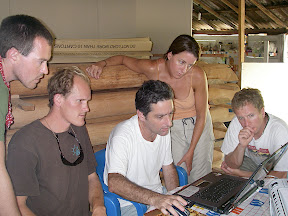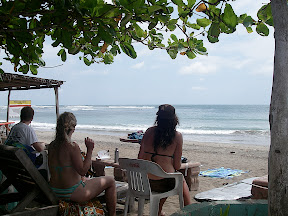Hi Gary, Harold, and Rotary friends,
I hope you're doing well this summer, and that the ash hasn't been too bad. I hope that the fires in Santa Barbara will soon be under control, if they aren't already.
I've been having an amazing time so far during my trip. First, I spent two weeks in Mexico, in the vicinity of Zihuatanejo (just north of Acalpuco, in the southern part of the mainland) doing research for my graduate thesis. The other 4 people in my group were also there, and we did several site visits to Playa Viva, which is the eco-resort that we are using as our case study. Our group is looking at examples of socially responsible investment in property, with a focus in the tourism industry in Mexico, and this could turn out to be a good role model for "green development".

Our first tour of the Playa Viva site was carried out impromptu by someone we met on the road: Canadian expat Bob, who has spent 30 years in the area and makes Aztec stone sculptures. The site is a mix of estuaries, palm trees, native vegetation, and sand dunes - it's really beautiful and full of animals - 85% of the land will remain preserved according to Playa Viva's plans. Canadian Bob took us to the turtle sanctuary, which Playa Viva helps support, and we watched newborn turtles scurry into the ocean. In days to come we also met with the architect, the permaculture specialist, and other community members.

Besides the turtle sanctuary, Playa Viva assists the community agriculture program in the area, which promotes organic farming practices; as well as the recycling program in the local township. The resort will be built with natural materials and will have on-site solar energy generation. Most impressively, they have an extensive restoration project to bring back the native vegetation and restore one of the lagoons which previous palm plantations had filled. In all, the development could actually improve the biodiversity of the region, and will hopefully bring positive benefits to the local community. We are now conducting background research on the project, which will be discussed in greater detail in our master's thesis. Although every development has impacts, and none can be perfect, it's still exciting to see that people are becoming increasingly conscientious about environmental and social issues these days.

Besides working on our project, we also spent plenty time of at the beach - the days were warm with a nice amount of cloud cover, and regular thunderstorms would cool down the temperature. Every other night there were lightning storms which we watched in the distance or hunkered down as they went over us. Even so, we often used fans or A/C to stay cool at night. During the days, we drove north to different surfspots, where we'd rent boards and get waves; or we'd drive south into Zihuatanejo itself (about 30 minutes) to get a bite to eat. Often, we just stayed at home and enjoying the ocean right in front, since we were fortunate to be in a beautiful house on the beach - courtesy of the family of one of our team members.
 Crossing the channel from Baltra to Santa Cruz Island, Galapagos
Crossing the channel from Baltra to Santa Cruz Island, GalapagosAfter my two weeks finished, I had a full day of travel to arrive in Guayaquil, the second largest city in Ecuador, which lies on the southern part of the coast. Although it seemed fairly peaceful, a number of people advised me to be careful in Guayaquil - the folks from the organization I will be interning with organized a homestay with a family. It was quite nice, their son showed me around the town and we had some good Ecuadorian meals - plantains, beans, roast beef, etc. I spent two night there, and then got the morning flight to the Galapagos islands.
At my school (Bren School of Environmental Science and Management, at UCSB), all the master's students need to complete a summer internship. I was lucky enough (and worked hard for it!) to find an internship in the Galapagos with Conservation International, an organization whose mission is to support biodiversity of flora and fauna around the world. My work will likely be in the financing and communication documents to support a research vessel based in the Wolf and Darwin Islands, a remote part of the archipelago that is a breeding ground for hammerhead sharks and whale sharks.

The fishing port at Puerto Ayora, Santa Cruz Island
I arrived on Saturday, and the plane landed on the small island of Baltra; we then took a shuttle to a ferry, in order to cross the channel and arrive in the island of Santa Cruz; at which stage we took a taxi (they are all white pickup trucks here) which took me to the main town of Puerto Ayora, and finally to my accommodations at the Charles Darwin Foundation, where I am being housed. It is located in the outskirts of town, right on the water's edge, with lush vegetation all around. Walking around, one must be careful not to step on the ubiquitous marine iguanas; this is especially challenging as they like to flounder on the black lava rocks by the beach, and camouflage perfectly so that it looks as if "the rock starts moving".
Marine Iguana that likes to hang around near the "comedor".
At night in the waxing moon I walked about the property and watched the giant tortoises asleep - they're like big mounds. On Sunday my new Ecuadorian friends, who are volunteering at the Foundation, took me to the long sandy beach west of town, which also has a nice clear lagoon. The weather has been cloudy, this being the season for such conditions, but it makes things cool and comfortable even though we're right under the line of the Equator. The folks from Conservation International lent me a bicycle and I've been exploring the town, which is larger than I expected, but small enough that we often need to wait one week for "special supplies" like copies of my office keys.
I'll be here for a month and a half, after which I'll travel around the islands and the Ecuadorian mainland; and finally return to California around the 16th of September. I'll send other updates in the weeks to come.
Have a great summer and we'll talk soon!
Best,
Kristian
Nighttime on the waterfront of Puerto Ayora, Galapagos.








